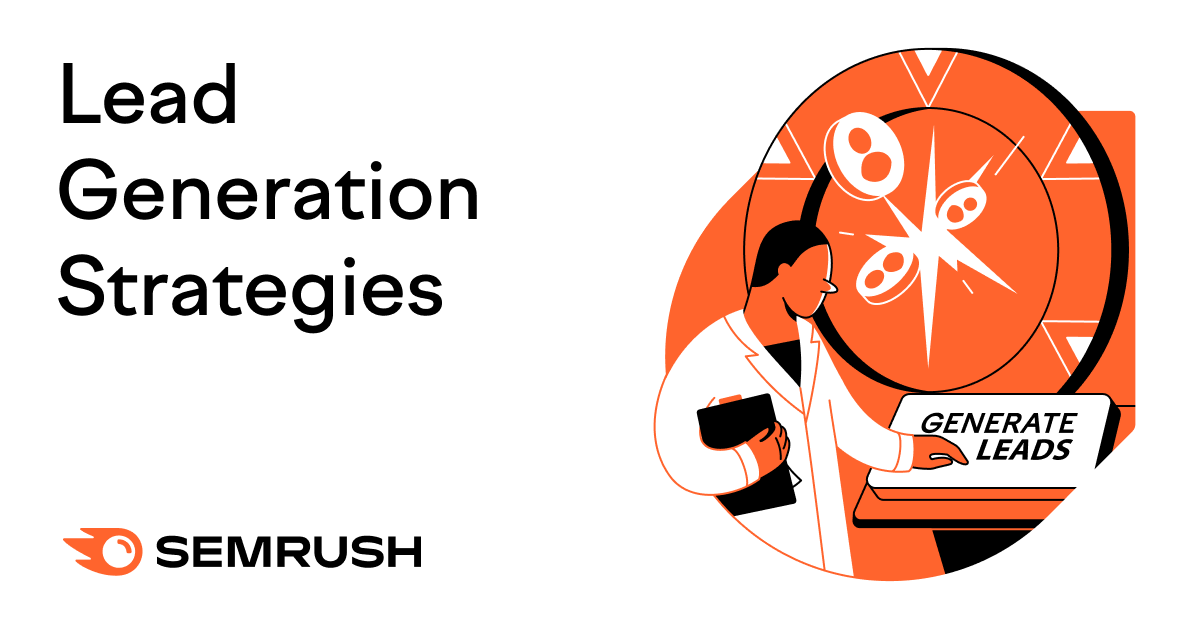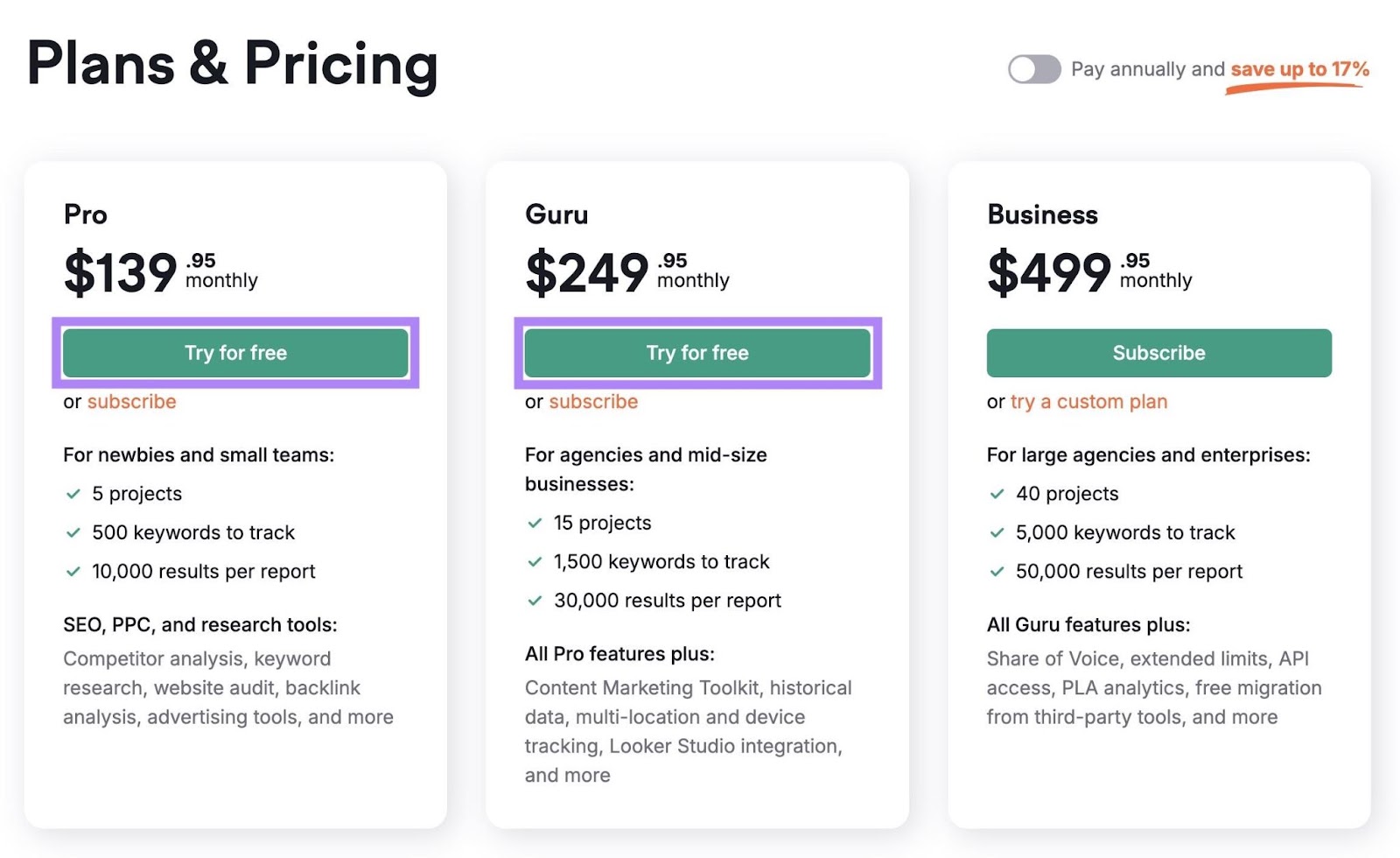
A lead generation strategy is a plan for getting potential customers to share their contact details with you and agree to receiving marketing or sales communications (i.e., become leads).
The goal is to identify high-intent prospects (potential customers most likely to convert) and build trust that encourages them to make a purchase.
A good lead generation strategy can:
- Fill your sales pipeline with quality leads
- Help you focus on the most promising potential customers
- Build your email list for future outreach
This guide will walk you through 11 tactics that can be used in lead generation strategies to get high-quality leads.
1. Build Better Landing Pages
Landing pages are webpages designed specifically to convert visitors into leads by persuading them to take a particular action.
For example, this landing page has a clear call to action (CTA) for scheduling a product demo.

It (and most good landing pages) also has the following:
- A compelling headline that immediately tells visitors how your solution can help them. For example, “Get Fit in Just 30 Minutes a Day—No Equipment Needed!”
- A clear subheading that highlights benefits, not just features, and focuses on how your offer can help the user. For example, “Burn fat, build muscle, and stay consistent with this free 4-week workout plan.”
- A user-friendly lead form that asks for your visitors’ email addresses and any other necessary information (but try to keep them short)
When possible, it’s also wise to incorporate social proof in the form of testimonials, case studies, or the number of people who’ve already benefited from your offer.
And be sure the thank you page that appears after the form submission and tells readers what to do next. For example, “Thank you for downloading our guide—check your email for the copy we’ve sent. And check out our other helpful resources on our [linked website section].”
Use the Landing Page Builder app to create high-converting landing pages for your business.

2. Optimize Lead Generation Forms
Optimizing your lead generation forms to make it easy for visitors to give you their information can help you secure more form submissions.
Your forms are the final step in turning visitors into leads. If they’re hard to use or ask for too much information, people might not fill them out.
Here are some tips for creating good lead generation forms:
- Keep it simple. Only ask for the information you truly need. For example, a name and email address might be enough to start.
- Add a strong CTA. Use a clear, action-oriented button that says something like “Get Your Free Quote” or “Download Now” instead of generic text like “Submit.”
- Use auto-fill options. Incorporate auto-fill capabilities to help users complete forms faster, especially on mobile devices.
- Show trust indicators. Add a privacy disclaimer like “We respect your privacy” or include security badges if applicable
Use the Lead Generation Forms app to create forms and quizzes that get more leads.

3. Use SEO to Drive Organic Traffic
Search engine optimization (SEO) can help your website rank higher in organic (unpaid) search results for relevant keywords (words or phrases people type into search engines) to drive more visitors who could become leads.
For example, Mailchimp has one of the top results for the term “email marketing platform.”

According to Semrush’s Organic Research tool, this page gets more than 454K organic visits per month.

And the page itself has a prominent CTA encouraging users to convert by signing up for a free trial.

That means this page can generate a lot of leads simply by getting people to click through from the search engine results page (SERP).
To increase the likelihood of lead generation via SEO, target high-intent keywords. Meaning terms that users search when they’re likely to convert.
The page above does this.
4. Offer a Free Trial or Plan
If you sell products, offering a free trial or plan is an enticing way to persuade prospects to give you their information (i.e., become leads).
You can then use that information to communicate with them and via emails that share helpful tips, highlight benefits, and share case studies. Which may turn them into paying customers.
For instance, Semrush offers a seven-day free trial. Which gives new users full access to a Pro or Guru plan.

Users who find the tools useful and want to continue using them can then easily transition to a paid plan.
Similarly, SurveyKing offers a free plan that lets users create surveys at no cost.

5. Add a Live Chatbot to Your Site
A live chatbot can help you answer visitors’ questions to ensure they find what they’re looking for. Which makes them less likely to leave.
Chatbots can even help with collecting visitors’ information.
For example, Kantata has live chat functionality that invites visitors to request a demo or connect with an expert. And encourages prospects to share their contact details and talk about their specific needs.

The conversational approach can make visitors more comfortable with sharing their data.
And that information can then be used to nurture relationships.
Eventually, those leads may become customers.
6. Run Lead Generation Ads
Lead generation ads are promotions designed to capture prospects’ information by getting them to sign up for or subscribe to something.
You can use various types of online ads to drive traffic to lead generation landing pages. Such as paid search, paid social, and display ads.
For instance, here’s a paid search ad promoting corporate accounting software:

This ad directs prospects to a landing page that features a lead generation form.
Some ad platforms also offer built-in lead generation tools. Which eliminates the need to direct users to a separate landing page.
For instance, you can run lead gen ads on Facebook to collect users’ information within the platform itself. Which makes the process quicker and easier for prospects, reducing the risk of drop-off.

On Google Ads, you can use lead form assets to add CTA banners to your ads.
These CTAs open lead generation forms directly in the ad.

7. Use a Lead Capture Pop-Up
A lead capture pop-up is a small box that appears on your website to collect visitors’ contact details.
These pop-ups grab users’ attention while they’re browsing and encourage them to share their information—often in exchange for something valuable.
For example, this lead capture pop-up encourages visitors to share their contact details in exchange for an ebook:

However, these popups can annoy users if they’re not timed well.
Here’s are some good options:
- Scroll-triggered pop-ups: Show the pop-up after visitors scroll a certain portion of the page. For example, trigger it halfway through a blog post.
- Exit-intent pop-ups: Show the pop-up when visitors are about to leave the site
- Time-delayed pop-ups: Display the pop-up after the visitor spends a set amount of time on your page
Semrush blog posts have scroll-triggered pop-ups that look like this:

When done right, lead capture pop-ups generate leads without being too disruptive to the user experience.
8. Run Retargeting Campaigns
One type of retargeting campaign shows ads specifically to users who visited your website without taking an action like submitting a form or making a purchase.
For example, if someone visits a website offering free marketing guides but doesn’t download the guide (which requires submitting their email), a retargeting ad can bring them back.
Later, while scrolling through social media, they might see an ad promoting the same guide.
Here’s a quick look at how retargeting campaigns work:

Use platforms like Google Ads, Meta Ads Manager, and LinkedIn Campaign Manager to set up retargeting campaigns.
Being active on social media means consistently publishing high-quality content and engaging with your audience in a meaningful way. This can translate to more leads over time.
You can even find ways to incorporate links to conversion-focused pages on your site.
For example, this U.S.-based social media management company has added a link to their contact page on their Instagram profile.

To make the most of your social media efforts:
- Publish high-quality content. Share social media posts that genuinely address your audience’s problems
- Choose the right platforms. Focus on platforms where your target audience spends time.
- Test different content formats. Experiment with different content formats like photos, videos, carousels, reels, stories, and live streams to see what works for your business.
- Engage with your audience. Actively respond to comments, answer questions, and join conversations to build trust.
Use Semrush Social to manage your social media efforts seamlessly across multiple platforms from a single dashboard.
10. Run Contests and Giveaways
Running contests and giveaways is an excellent way to get leads because the anticipation of winning creates excitement and a sense of urgency that drives potential customers to participate.
Here’s an example of a giveaway Quiksilver hosted on their site:

Here are some ideas for places where you can run and/or promote contests and giveaways:
- Social media: Platforms like Instagram, LinkedIn, Facebook, and X. Best for brands with an active following.
- Email campaigns: Invite your email list to participate. Best for nurturing existing leads.
- Event booths: Host contests at live events or expos. Best for local lead generation.
- Your site: Embed giveaways directly on your site. Best for websites with high traffic.
- Partner sites: Collaborate with influencers or publishers. Best for tapping into new audiences.
The actual steps for participation can vary. If you’re running a contest on your website, form submissions typically work best.
But if you use social media, actions like following the business, using a hashtag, or tagging an account can work as entry requirements.
Keep in mind that choosing the right prize is important. Because different prizes engage different kinds of participants.
For example, offering a cash prize might attract a wide range of participants who might not even be interested in your business.
On the other hand, offering a yearly subscription to your software or a product bundle makes sure only genuinely interested users participate in the contest.
11. Use Customer Review Sites
Encourage customers to share their experiences on review sites to increase visibility that can translate to more leads.
This works because positive reviews from satisfied customers builds trust and credibility with prospects who are researching businesses before making buying decisions.
Here are some review sites to consider:
- For local businesses: Google, Yelp, TripAdvisor, Angi
- For software companies: G2, Capterra, TrustRadius, Software Advice
For example, Slack has positive ratings on G2, which helps to instill confidence in potential leads.

So, encourage your satisfied customers to leave reviews by reaching out via email or messaging once they’ve had time to experience your product or service.
And when you get reviews, respond to them.
This shows prospects that you care about feedback. And gives you the opportunity to neutralize any negative comments.
Keeping tabs on your reviews is easy if you use Semrush’s Review Management tool. Which allows you to track reviews across multiple directories. And reply directly to Google reviews.
Measure Your Lead Generation Efforts
Regularly analyze results to identify areas for improvement.
And double down on lead generation tactics that yield the best results.
Thankfully, Semrush tools can help with many of these lead generation ideas. Try it today.







